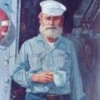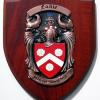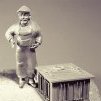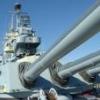-
Posts
3,084 -
Joined
-
Last visited
Reputation Activity
-
 Jaager got a reaction from mtaylor in POF Question
Jaager got a reaction from mtaylor in POF Question
Do you plan to fully plank both sides of the hull?
Yes. - Then it should do.
In making the sandwich, with PVC glue - within reason - higher clamping pressure = stronger bond. Uniform pressure for all sandwiches will yield reproducible results.
No - Will it bother you that each displayed frame will have an offset seam near the center with a different grain pattern on each side?
-
 Jaager got a reaction from Canute in POF Question
Jaager got a reaction from Canute in POF Question
Do you plan to fully plank both sides of the hull?
Yes. - Then it should do.
In making the sandwich, with PVC glue - within reason - higher clamping pressure = stronger bond. Uniform pressure for all sandwiches will yield reproducible results.
No - Will it bother you that each displayed frame will have an offset seam near the center with a different grain pattern on each side?
-
 Jaager got a reaction from garywatt in scroll saw proxxon ds 460
Jaager got a reaction from garywatt in scroll saw proxxon ds 460
A generic 9" tabletop band saw with a 1/8" blade will do an excellent job of scroll cutting. With a Carter Products Blade Stabilizer, scroll cutting is even better. Change to a 1/2" blade and you can do some resawing (in the 1-2 " stock range) and cross cutting (you might could rig a carrier/slide table like with a table saw - the back would need to be uncut to keep the two sides attached). Inside scroll cuts and extreme curves can be done with a hand fret/scroll saw.
It gives you a more versatile machine.
See the size of readily available replacement blades (59 1/2 here) and make sure they fit the saw you choose.
If the Carter upgrade is do-able as far as cost, make sure your model choice will fit one.
-
 Jaager got a reaction from mtaylor in Wood used for deadeyes?
Jaager got a reaction from mtaylor in Wood used for deadeyes?
Black Walnut is an attractive wood - for furniture - the grain is tight, so it does not fuzz or roll out as you work it, but it is open, so it is not really the best for 1:48 scale or smaller, especially small parts like deadeyes , blocks, rails, combing, bits, etc. European kit assemblers probably use a different species, but what I see is still open grain and not as rich a color as Juglans nigra even.
I am not familiar with SoCal botany, but see if you can source a dead branch of a Dogwood tree - a live one will work, but you would need it to season before you can use it.
If you have old formal gardens there, see if you can get pieces of Boxwood. Real Boxwood (Buxus simpervirans) from temperate gardens is tight grained and hard as a rock - tough to work. It may have a faster growth pattern in your warmer climate. When you prune it (saw out a sizable branch) you will quickly appreciate just how hard a wood it is.
Rock Maple would be better than Walnut. Black Cherry would be better than Walnut. Either would do a good job, they are just softer and faster working than Dogwood or Boxwood. Holly will work and it can be dyed to match any shade of wood.
-
 Jaager got a reaction from flying_dutchman2 in Model building software ideas
Jaager got a reaction from flying_dutchman2 in Model building software ideas
Look at GIMP. It is free. Similar textures - brick/ wood/ shingle - are also available for free on line - usually as tiles - some seamless, most not.
-
 Jaager got a reaction from mattsayers148 in At what point of modifications would a kit become "Kit Bashed"
Jaager got a reaction from mattsayers148 in At what point of modifications would a kit become "Kit Bashed"
I had been thinking that "kit bashing" implied the production of a chimera - a fantasy object.
In ship modeling the usual goal is produce as accurate a representation of an actual vessel as is possible - given the skill and data available. If that is the result, then how you get there is not much of an issue. There is no real "bashing" here.
When I read a post about a POB kit where the author states that the centerline keel piece, molds, and planking has been replaced with higher quality material - I wonder - why not just buy only the plans and hardware to begin with? It has essentially become a scratch build at this point anyway.
-
 Jaager got a reaction from Canute in At what point of modifications would a kit become "Kit Bashed"
Jaager got a reaction from Canute in At what point of modifications would a kit become "Kit Bashed"
I had been thinking that "kit bashing" implied the production of a chimera - a fantasy object.
In ship modeling the usual goal is produce as accurate a representation of an actual vessel as is possible - given the skill and data available. If that is the result, then how you get there is not much of an issue. There is no real "bashing" here.
When I read a post about a POB kit where the author states that the centerline keel piece, molds, and planking has been replaced with higher quality material - I wonder - why not just buy only the plans and hardware to begin with? It has essentially become a scratch build at this point anyway.
-
 Jaager got a reaction from Canute in Crown Timberyard, evaluation of some wood sheets
Jaager got a reaction from Canute in Crown Timberyard, evaluation of some wood sheets
Harvesting your own wood, or starting with lumberyard stock is not a requirement for scratch building. It is more something like a fetish for those of us who want to "live off the grid" for our wood sources.
As far as scratch building is concerned, I consider that it means starting with just plans and assembling a vessel. It is freedom from the limitations from the offerings of kit manufacturers.
Using pre-made hardware such as cannon or eye bolts, does not alter that, although it may run afoul of some contest rules if competition is something that you enjoy. I think that the metal parts are more of a Model Engineering skill.
Prototype ship builders did not hesitate using outside manufacturers to provide wheels, winches, or anything else they could get as soon as the Industrial Age began. There is no reason a modeler should not do the same if the part matches and is the correct scale - if that is how they wish it.
Not relevant to anything:
I would not build a scratch model at the same scale of any vessel available as a kit.
I would never use POB as a method to scratch build.
-
 Jaager got a reaction from jml1083 in Crown Timberyard, evaluation of some wood sheets
Jaager got a reaction from jml1083 in Crown Timberyard, evaluation of some wood sheets
The product reports out as being both precise and accurate. If you redo the measurement in the Summer in a high humidity environment, it is possible the the values would be higher. The point being that with wood, a bit of latitude is appropriate with accuracy. This product is excellent.
-
 Jaager got a reaction from RichardG in Crown Timberyard, evaluation of some wood sheets
Jaager got a reaction from RichardG in Crown Timberyard, evaluation of some wood sheets
Harvesting your own wood, or starting with lumberyard stock is not a requirement for scratch building. It is more something like a fetish for those of us who want to "live off the grid" for our wood sources.
As far as scratch building is concerned, I consider that it means starting with just plans and assembling a vessel. It is freedom from the limitations from the offerings of kit manufacturers.
Using pre-made hardware such as cannon or eye bolts, does not alter that, although it may run afoul of some contest rules if competition is something that you enjoy. I think that the metal parts are more of a Model Engineering skill.
Prototype ship builders did not hesitate using outside manufacturers to provide wheels, winches, or anything else they could get as soon as the Industrial Age began. There is no reason a modeler should not do the same if the part matches and is the correct scale - if that is how they wish it.
Not relevant to anything:
I would not build a scratch model at the same scale of any vessel available as a kit.
I would never use POB as a method to scratch build.
-
 Jaager got a reaction from mtaylor in Crown Timberyard, evaluation of some wood sheets
Jaager got a reaction from mtaylor in Crown Timberyard, evaluation of some wood sheets
Harvesting your own wood, or starting with lumberyard stock is not a requirement for scratch building. It is more something like a fetish for those of us who want to "live off the grid" for our wood sources.
As far as scratch building is concerned, I consider that it means starting with just plans and assembling a vessel. It is freedom from the limitations from the offerings of kit manufacturers.
Using pre-made hardware such as cannon or eye bolts, does not alter that, although it may run afoul of some contest rules if competition is something that you enjoy. I think that the metal parts are more of a Model Engineering skill.
Prototype ship builders did not hesitate using outside manufacturers to provide wheels, winches, or anything else they could get as soon as the Industrial Age began. There is no reason a modeler should not do the same if the part matches and is the correct scale - if that is how they wish it.
Not relevant to anything:
I would not build a scratch model at the same scale of any vessel available as a kit.
I would never use POB as a method to scratch build.
-
 Jaager got a reaction from GLakie in Crown Timberyard, evaluation of some wood sheets
Jaager got a reaction from GLakie in Crown Timberyard, evaluation of some wood sheets
Harvesting your own wood, or starting with lumberyard stock is not a requirement for scratch building. It is more something like a fetish for those of us who want to "live off the grid" for our wood sources.
As far as scratch building is concerned, I consider that it means starting with just plans and assembling a vessel. It is freedom from the limitations from the offerings of kit manufacturers.
Using pre-made hardware such as cannon or eye bolts, does not alter that, although it may run afoul of some contest rules if competition is something that you enjoy. I think that the metal parts are more of a Model Engineering skill.
Prototype ship builders did not hesitate using outside manufacturers to provide wheels, winches, or anything else they could get as soon as the Industrial Age began. There is no reason a modeler should not do the same if the part matches and is the correct scale - if that is how they wish it.
Not relevant to anything:
I would not build a scratch model at the same scale of any vessel available as a kit.
I would never use POB as a method to scratch build.
-
 Jaager got a reaction from GLakie in Crown Timberyard, evaluation of some wood sheets
Jaager got a reaction from GLakie in Crown Timberyard, evaluation of some wood sheets
The product reports out as being both precise and accurate. If you redo the measurement in the Summer in a high humidity environment, it is possible the the values would be higher. The point being that with wood, a bit of latitude is appropriate with accuracy. This product is excellent.
-
 Jaager got a reaction from Canute in Varnish and primer
Jaager got a reaction from Canute in Varnish and primer
Primer is to seal the wood and provide a smoother surface for follow on paint or "varnish".
Shellac (thinned to 50% if using a product already in solution) is the classic primer.
Tung oil diluted to 50% (1:1) by mineral spirits is another type of primer. Tung followed by primer strength shellac is another choice.
Classic vanish is boiled Linseed oil heated to dissolve in shellac - not really a DIY product.
Sand and Sealer is a product that is primarily intended for use on open grain/open pore wood like Oak, Hickory, Walnut. It tends to be thick in consistency and will leave a layer that might be out of scale (too thick).
The reason that a mat finish (egg shell) is preferred is one of scale effect. Most of us produce models that are between 1:50 and 1:100 of the actual vessels. An actual vessel with a high gloss finish would appear as having a mat finish if viewed clearly from a distance where it was seen as 1-2% of its actual size.
To use polyurethane on your model is a matter of whether you are prejudiced against using plastic on your model.
-
 Jaager got a reaction from geoff in Varnish and primer
Jaager got a reaction from geoff in Varnish and primer
Primer is to seal the wood and provide a smoother surface for follow on paint or "varnish".
Shellac (thinned to 50% if using a product already in solution) is the classic primer.
Tung oil diluted to 50% (1:1) by mineral spirits is another type of primer. Tung followed by primer strength shellac is another choice.
Classic vanish is boiled Linseed oil heated to dissolve in shellac - not really a DIY product.
Sand and Sealer is a product that is primarily intended for use on open grain/open pore wood like Oak, Hickory, Walnut. It tends to be thick in consistency and will leave a layer that might be out of scale (too thick).
The reason that a mat finish (egg shell) is preferred is one of scale effect. Most of us produce models that are between 1:50 and 1:100 of the actual vessels. An actual vessel with a high gloss finish would appear as having a mat finish if viewed clearly from a distance where it was seen as 1-2% of its actual size.
To use polyurethane on your model is a matter of whether you are prejudiced against using plastic on your model.
-

-
 Jaager got a reaction from GuntherMT in Probably the dumbest planking question ever....
Jaager got a reaction from GuntherMT in Probably the dumbest planking question ever....
It is a small piece of wood (end cuts/ scrap usually) at the end of the pin. Just pinning a plank to a frame is good for locating it, but it does not apply much downward clamping pressure. If you use the pinhead to apply the pressure, a dent larger the the trunnel is often made. If the pin is thru doweled, the piece of wood is between the pinhead and the plank. If the pin hole is shallow, the pin is bent above the wood piece to apply the pressure.
If you want to go old school, the wood piece is split off and the pin nipped at the plank surface. You then have brass trunnels. If you want wood or bamboo trunnels, the whole hutchcock is removed and the pin hole bored to match the trunnel diameter.
-
 Jaager got a reaction from mtaylor in Probably the dumbest planking question ever....
Jaager got a reaction from mtaylor in Probably the dumbest planking question ever....
It is a small piece of wood (end cuts/ scrap usually) at the end of the pin. Just pinning a plank to a frame is good for locating it, but it does not apply much downward clamping pressure. If you use the pinhead to apply the pressure, a dent larger the the trunnel is often made. If the pin is thru doweled, the piece of wood is between the pinhead and the plank. If the pin hole is shallow, the pin is bent above the wood piece to apply the pressure.
If you want to go old school, the wood piece is split off and the pin nipped at the plank surface. You then have brass trunnels. If you want wood or bamboo trunnels, the whole hutchcock is removed and the pin hole bored to match the trunnel diameter.
-
 Jaager got a reaction from GLakie in MDF for laser-cutting new frames
Jaager got a reaction from GLakie in MDF for laser-cutting new frames
I think you should be careful about terminology. The transverse parts in POB are actually molds of the cross sectional hull shape rather than being bulkheads and they certainly are not frames. They are just where a few of the frames would be. Bulkhead is a useful short hand term to describe the unit, but using "Frame" would cause confusion.
MDF is as much the binder as it is wood fibers. The binder is what would be toxic. For many of us there is a philosophical split between using Nature supplied components and man made components. Plywood is a step towards man made for pre 1880's ship models and MDF is major step in the plastics direction.
-
 Jaager got a reaction from russ in Probably the dumbest planking question ever....
Jaager got a reaction from russ in Probably the dumbest planking question ever....
I have read a lot of articles covering POF techniques and I can't recall any where the ceiling was applied first. But in most of them - the outside planking was completely or partially omitted to show the frames.
Russ exactly stated my thoughts on how it should be done.
In real practice, I think it was also done as Russ stated.
One - I think the outside planking was thru doweled and thru nailed. The inside planking would be messed up if was present.
Two - in many vessels, the space between the frames was filled with rock salt as the ceiling went up, so the planking would need to be there.
For models
I am of the Underhill school of belt and suspenders ( glue and dowels for all joining ). In this case, the planking is held by lil pins with hutchcocks instead of clamps - the pin holes being later enlarged to trunnel diameter. It does mean that the lil pin locations need to match the final trunnel pattern.
-
 Jaager got a reaction from kees de mol in Organizer and drill-bits
Jaager got a reaction from kees de mol in Organizer and drill-bits
Not my idea, but a 2 inch block of Styrofoam wall insulation (blue or pink), cut to whichever X/Y dimensions needed, and hot glued to a 1/2" plywood base makes a good bench top organizer. Home Depot sells 1 x 2 sheets of 1 inch for misc use that is not expensive and two layers can be hot glued up.
-
 Jaager got a reaction from augie in Probably the dumbest planking question ever....
Jaager got a reaction from augie in Probably the dumbest planking question ever....
I have read a lot of articles covering POF techniques and I can't recall any where the ceiling was applied first. But in most of them - the outside planking was completely or partially omitted to show the frames.
Russ exactly stated my thoughts on how it should be done.
In real practice, I think it was also done as Russ stated.
One - I think the outside planking was thru doweled and thru nailed. The inside planking would be messed up if was present.
Two - in many vessels, the space between the frames was filled with rock salt as the ceiling went up, so the planking would need to be there.
For models
I am of the Underhill school of belt and suspenders ( glue and dowels for all joining ). In this case, the planking is held by lil pins with hutchcocks instead of clamps - the pin holes being later enlarged to trunnel diameter. It does mean that the lil pin locations need to match the final trunnel pattern.
-
 Jaager got a reaction from tkay11 in Wood Selection/thickness questions
Jaager got a reaction from tkay11 in Wood Selection/thickness questions
A two deck fourth rate vessel will be a challenging first for scratch POF. It is possible. I would suggest a cutter, schooner, or small brig to begin, but they are not as "sexy" as a Ship-of-the-Line when first looking at this endeavor.
POF is certainly closer to how the original vessels were built. It is my preference.
Except for the building board, there is not much use for plywood with POF.
The major sources of cost will be the tools, not the wood.
You can use locally available species. Some of us harvest our own from the "wild".
My favorite - Apple - is not often obtainable any other way.
Lime (Linden/Basswood) will work for much, if not all. - I prefer harder wood, but that is an individual choice.
Some species are open grain - open pores - have high contrast between Spring and Summer wood and do not look good to me when simulating wood at model scales ; Oak, Walnut, Mahogany, Hickory, Aspen. But again, that is a personal preference.
You can use hand tools for much of the work. If you use Lime, hand tool work will be faster than with the harder species.
-
 Jaager got a reaction from mtaylor in Wood Selection/thickness questions
Jaager got a reaction from mtaylor in Wood Selection/thickness questions
From the questions that you ask, it appears that you are scratch building HMS Leopard.
Asking about a plywood keel suggests that you are planning to use POB as the method to form the hull.
The materials used to build the hull of a late 18th century warship is a bit more involved than a single thickness of planking. The sizes of the parts of the hull are what is called Scantlings.
The easiest source for these:
As for Leopard, she is well documented in the following book:
There is even a set of removable plans at 1:96
-
 Jaager got a reaction from Archi in Classic old Dutch Treatise by Nicolaas Witsen 1671
Jaager got a reaction from Archi in Classic old Dutch Treatise by Nicolaas Witsen 1671
www.tamupress.com














